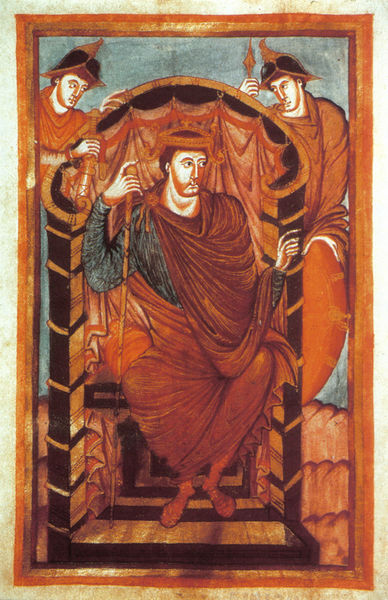Sometimes I come across things I just really should have known. This is quite a substantial one, because you’d think that by now I’d have more or less got up to speed with Carolingian numismatics. But one of the things I ‘knew’ about Carolingian numismatics is that the Carolingians don’t mint coins with their portraits on. And whereas with a lot of medieval kings the coins are the only contemporary portraits we have, with the Carolingians we’re actually not badly off. Charlemagne himself is a bit of a problem, unless the famous equestrian statue actually is him and contemporary:
But Hraban Maur put a lot of effort into depicting Louis the Pious:
Even Lothar I, who is generally undersourced, exists in paint and parchment:
And Charles the Bald has several depictions out there, of which the stock one is so like Lothar there, for all that the manuscript it’s in was supposedly presented to Charles, that I actually thought one of the others might be more representative:
And there’s more than a bit of family resemblance, too, which has always amused me. But but but. Turns out Charlemagne did mint a portrait coinage, although possibly only for two years, after the Byzantine emperor had recognised his title as Holy Roman Emperor in 812. There’s one in the Fitzwilliam, even, I’ve sat next to classes where it was being handed round (very carefully) and never noticed. Pah. Ours isn’t online, but this image is:
Check out the moustache too; it more or less matches the one on the statue. Furthermore, for a short while his son Louis the Pious continued the theme with a version of his own:
This one’s particularly fun for numismatists because it’s from Melle, where the Empire’s major silver mines are and so it has on the reverse the hammers and dies for striking the coinage that was the town’s major interest. Well, there we go: don’t tell the interview panels how shaky my knowledge is please…
Edit: further enquiry reveals that Lothar I also minted some portrait issues, probably in Italy. So really I should have just held this post back a month or so more and posted more holiday photoes… But, although I haven’t been able to find an image of Lothar’s coins that’s either online or copyright-loose, they seem pretty cartoonish; I can’t help but wonder if he was using coins of Constantius II as a model, which are also pretty bizarre. In any case. For all I know, it seems, all the Carolingians put their faces on coins once in a while. I’m just not going to risk any more generalisations on the subject.
I actually found all this out by reading the Reverend Simon Coupland’s “Charlemagne’s coinage: ideology and economy” in Joanna Story (ed.), Charlemagne: Empire and Society (Manchester 2005), pp. 211-229 and his “Money and coinage under Louis the Pious” in Francia Vol. 17 (Sigmaringen 1990), pp. 23-54, both reprinted in Coupland, Carolingian Coinage and the Vikings: studies on power and trade in the 9th century, Variorum Collected Studies, I & III respectively.








Another widespread idea about Carolingian coins is that there was no minting of obols before Louis the Pious. It is clearly not true, as some coins are known for Charlemagne both before and after the reform of 793/4.
I would add in your list Charles the Bald who minted some portrait coins (only at Bourges before 864 from the available data).
As far as I know, the only Carolingian obols that bear a portrait are Louis the Pious, for a very limited number of mints.
Pingback: Have you seen this emperor? « A Corner of Tenth-Century Europe